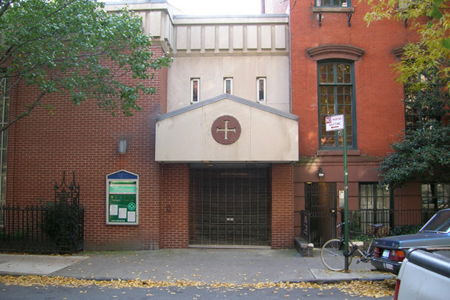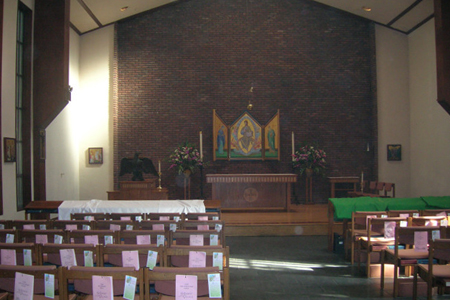| |
 |
 |
 |
| Comment on this report, or find other reports. |
 |
| Our Mystery Worshippers are volunteers who warm church pews for us around the world. If you'd like to become a Mystery Worshipper, start here. |
 |
| Find out how to reproduce this report in your church magazine or website. |
|
|
| 1653: St John's
in the Village, New York City |
 |
 |
 |
Mystery Worshipper:
Clandestine Christian.
The church:
St John's
in the Village, New York City, New York.
Denomination:
The Episcopal Church, Diocese
of New York.
The building:
The original 1847 Greek Revival building, which had been home
to various Protestant churches until the Episcopal congregation
took over in 1856, burned down in 1971. The current building
is by Edgar Tafel, who was an apprentice of Frank Lloyd Wright,
and was finished in 1974. It more resembles a handsomely designed
Protestant structure than an Anglo-Catholic/Episcopal church.
Tall multi-paned windows line the white walls on each side,
suggesting columns, and while they are not stained glass, the
morning sun comes through the windows, softly warming the interior.
In between the windows are the stations of the cross in Greek
icon style. The Greek influence is carried over to the altar
triptych, Christos Pantokrator, with gold backgrounds and greens,
blues and pinks. The latter is the work of Greek Orthodox deacon
and iconographer Christopher Kosmas (d.1992). The reserved Sacrament
is kept in a hanging pyx in lieu of the usual tabernacle. A
lovely courtyard garden can be seen from the large windows in
the hall that leads to the meeting rooms and offices; the houses
that surround the courtyard once all belonged to the church
until they proved too expensive. Most intriguing was a sign
that read, "Horsewalk exit to 11th street." When I was leaving,
the entrance gate had been shut and I had to take the horsewalk
exit; it was a long and narrow well-lit tunnel which led out
through an iron gate to the street.
The church:
The many ministries include an AIDS ministry with an emphasis
on Christian spirituality, a chaplaincy at nearby St Vincent's
Hospital, two food programs for the hungry, a program with orphans
from the New York Foundling Hospital, a counseling center, and
a street youth program. The space of the church is used for
community and 12-step groups, a theater group which also involves
the congregation, and various education and musical programs.
Worship services are held Sundays at 8.00 and 11.00, Mondays
and Fridays at 6.15pm; healing services Wednesdays at 6.15,
and morning prayer weekdays at 8.00am. The church is completely
gay-friendly, wheelchair accessible, and offers sign language
on the second Sunday of each month at the 11.00 service. St
John's website is a ministry in itself, with many articles and
features; the homilies appear there and are indexed.
The neighborhood:
This is the part of New York's Greenwich Village known as the
West Village. It is lovely, historical, full of famous cafés,
restaurants, jazz clubs and taverns. The West Village features
quiet, narrow, tree-lined, residential streets, courtyards and
gardens, and has historically been (and still is) home to many
important literary and artistic figures. Bleecker Street, Christopher
Street, the Stonewall Inn (birthplace of the gay movement),
New York University, many interesting shops and parks –
all can be found in this most celebrated part of Manhattan.
The church is at Waverly Place and West 11th Street, just west
of Seventh Avenue.
The cast:
The Revd Lloyd Prator, rector, was celebrant and preacher, with
the Revd Samuel O. Cross, associate, assisting. Also assisting
were the Revd Deacon Mary B. Gregorius; Suzanne Culhane, subdeacon;
and Gordon King, organist and choirmaster.
The date & time:
All Saints' Sunday, November 2, 2008, 11.00am.
What was the name of the service?
Solemn Eucharist.
How full was the building?
Between half and three-quarters full. The congregation seemed
mainly over 50 and everyone was dressed casually.
Did anyone welcome you
personally?
I was welcomed outside the entrance doors by two women who wore
name tags. Upon entering, I was handed the service leaflet and
greeted again by another church member. When I was seated, another
women came and introduced herself and asked if I had come for
the music (the choir were doing Mozart's Coronation Mass). She went around and greeted everyone individually.
Was your pew comfortable?
There were comfortable chairs instead of pews, but they were
spaced a little too closely (see the hellish bits below).
How would you describe the pre-service
atmosphere?
It was quiet with some talking as people greeted each other.
What were the exact opening words of the
service?
(Chanted): "Blessed be God: Father, Son and Holy Spirit."
What books did the congregation use during the
service?
The Book of Common Prayer and the Hymnal 1982.
What musical instruments were played?
Organ, two violins, cello, choir and soloists.

Did anything distract you?
I couldn't help but be distracted by a gentleman who came in
off the street and was sitting quite close to me. He was unwashed
and didn't smell very good. He sat during the gospel reading
and renewal of baptismal vows and didn't seem able to follow
along. I found myself thinking about him too much, and when
the offering plate came around, I was wondering if he might
try to take a handful of cash. (I know that's terrible of me.)
I was pleased to see that he put a coin in; I don't think the
poor fellow had much money at all. During the sermon he was
fidgeting and scratching a lot and I got very distracted and
felt a little anxious. I wished I had changed my seat, but it
would have caused a terrible disruption. There was also something
that sounded in between a snore and a moan that kept repeating
and I didn't know where it came from, so it too was distracting.
At communion, I found it came from a gentleman in a wheelchair,
and then it was fine – it just scared me a little when I didn't
know what it was, especially on All Souls' Day.
Was the worship stiff-upper-lip,
happy clappy, or what?
The worship was formal with incense and processions, yet relaxed
and with some silent moments for contemplation. Almost everything
was sung, an interesting combination of traditional and modern.
The modern wasn't the happy clappy type of pop worship, but
more of a classical contemporary. Although the music was special
for All Saints' Day, the organ playing and singing were of such
high quality that I suspect the only difference from a regular
Sunday was the inclusion of the violins and cello.
Exactly how long was the
sermon?
11 minutes.
On a scale of 1-10, how good was the preacher?
8 – Father Prater exuded a down-to-earth friendliness and
intelligence; he used personal anecdotes and gave a well-crafted
miniature of a homily.
In a nutshell, what was the sermon
about?
It was about heroes. Father told about some of his childhood
heroes, and how they eventually disappointed or faded away,
as childhood heroes do. But the saints are heroes for adults.
They serve as models for us, encourage us, and provide fellowship.
He gave some examples of modern-day saints.
Which part of the service
was like being in heaven?
Being surprised by a beautifully sung prelude, with the sunlight
coming through long windows. That prelude was "Domine Deus"
from Bach's Mass in B Minor. This in addition to the
exquisitely performed Coronation Mass. And as if that
wasn't enough, the strings accompanied the hymns, and those
chosen happened to be favorites, such as "Ye watchers and
ye holy ones" to the tune of Lasst uns erfreuen.
You would think there would be a skimpy postlude after all that,
but no, it was Mozart's Sonata in C. The acoustics
in this building are perfect for chamber music and for speaking
as well. It was nice to be able to understand every word spoken;
no echoes and muffling, as in bigger spaces. This building was
designed for sound.
And which part was like
being in... er... the other place?
It was kind of hard with the guy who was smelly and itchy and
didn't stand or kneel being in front of me. After communion,
I wanted to kneel but he was sitting and the rows of chairs
were so close that I would have had my nose right in his hair,
so I sort of awkwardly maneuvered into the seat next to mine
to kneel. I sensed also that when I sat down the person behind
me couldn't continue kneeling. It made me wish for pews in which
one could more easily slide over to avoid that problem.
What happened when you hung around after the service looking lost?
Father Prater had announced coffee hour and said there would
be some special food for the holiday, so everyone either left
or made their way to that room. After five minutes I just went
to the coffee hour, since no one could have known I was standing
looking lost in an empty sanctuary. At coffee hour people welcomed
me and engaged me in conversation, including the rector.
How would you describe the after-service
coffee?
There was coffee and tea, both regular and decaf, two kinds of fruit punch, wraps with turkey and cheese, sandwiches with meat and cheese, lettuce and tomatoes in croissants, shrimp cocktail, various cakes, cookies and pastries. Paper plates but ceramic cups.
How would you feel about
making this church your regular (where 10 = ecstatic, 0 = terminal)?
8 – It would be nice to live close to St John's, get involved
and attend the other services, Bible studies, etc. Since it
was a holiday, with special music, I would like to visit again
sometime on a regular Sunday.
Did the service make you
feel glad to be a Christian?
Yes, it was very moving to be at such a service. As distracted
as I was by that man, I felt glad he was there and that he took
communion and attended coffee hour. It all felt very right,
as if this is what being a Christian is all about.
What one thing will you remember about all this in seven days' time?
I won't easily forget that music; I think the organ playing
might have been the best I've ever heard. It wasn't at all bombastic,
but full of subtle textures and colors. Combined with the strings,
it sounded like an entire chamber orchestra. |
|
|
 |
 |
 |
| We rely on voluntary donations to stay online. If you're a regular visitor to Ship of Fools, please consider supporting us. |
 |
 |
 |
| The Mystery Pilgrim |
 |
| One of our most seasoned reporters makes the Camino pilgrimage to Santiago de Compostela in Spain. Read here. |
 |
 |
 |
| London churches |
 |
| Read reports from 70 London churches, visited by a small army of Mystery Worshippers on one single Sunday. Read here. |
| |
|
|
|
|


